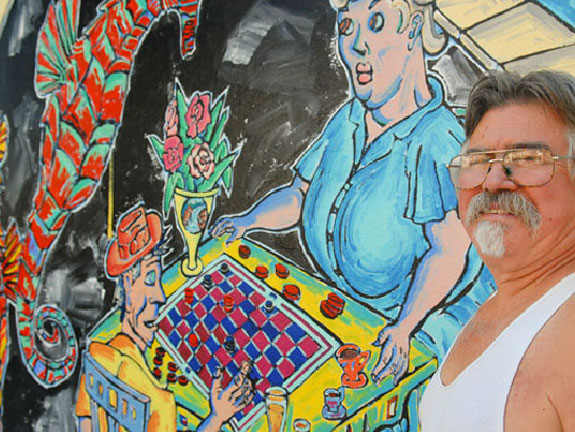Patrick Siler points to a crack in the wall he’s about to paint. He points to another, and another. He has to fill those. And there’s that slanted place in the concrete he has to deal with. He can’t push his lift onto the sloped surface. Maybe he’ll build a wooden platform to roll the lift onto. And the tree in front of the wall, well, he’ll figure that out when he gets to it.
“I still have quite a bit of preparatory work on this wall,” Siler says, sitting in the Thomas Hammer café where the mural is located. “I’ve done a lot of work on the building just so I can do my painting, scraping, filling, power washing.”

This summer, the retired WSU art professor put the finishing touches on the third and final part of the Pine Street Plaza Mural. It’s a larger scale than Siler’s ever worked on before, and he has to use a different set of skills to complete the piece. Siler has to draw the mural first, creating a grid he can then transfer to the wall. The whole process takes more than a month, and he can only paint when the weather allows. Otherwise, the paint won’t dry.
Siler has been working on the mural since 2009, when he completed the first part, “Skyhorses and the Finer Points of Solitaire & Checkers.”
The first part of the mural depicts a typical small town, where brightly-colored townsfolk play checkers and cards in the middle of Main Street. Generic businesses line the street: bars, clubs, a divorce attorney’s office. But floating through the sky are seahorses and sea turtles. Fish fly through the clouds along with an airplane. The animals spy on the people below, watching them play their otherwise average games.
Siler said the seahorses are for his wife, Elizabeth, an English as a second language specialist in the English department at WSU.
“You can imagine a seahorse is a pretty unique shape,” he says matter-of-factly. “There’s nothing that has the shape of a seahorse… It’s just an example of what I’ve been doing for years.”
The second part continues the theme, where crabs soar high above saxophone players performing on stage.
“There’s tension between these things that are so disparate,” he said.
Siler’s work draws from German Expressionism, comics of the 1930s and 1940s, and traditional Japanese and Chinese brushstrokes. Siler said he tries to find disparity in objects and put them together to “create visual fireworks,” things that may not go together and may not sell, but work because they are what he wants to create.
“I’d rather spend time developing something super duper with my art than do a half-ass job of that and go out and try to sell it,” he said. “I want to do the best art, the most original art, the most interesting art I can.”
In addition to completing the mural, Siler had his work displayed at the WSU Museum of Art this past summer. The Curator’s Choice exhibit featured several of Siler’s finished works, in addition to a series of sketches and drawings he did in preparation for the mural. The museum spent $4,000 from the permanent collection fund for the pieces, enough for him to purchase supplies to finish the mural.
“It’s a good thing for Pullman history and a former faculty member who taught here for many years, that he’s represented in the permanent collection in a way that’s not just a painting,” says Chris Bruce, the museum director. “It’s a way to share a person’s process as well as the end product.”
Siler was born in Spokane and grew up in Tacoma. Throughout his childhood, Siler was always interested in art, and took a sketch book everywhere he travelled.
He earned his bachelor’s degree in art studies from WSU in 1961. He then studied at the University of California, Berkeley, where he earned a master’s degree in painting in 1963. He says he tried to earn a teaching degree but could never complete it: He only wanted to be an artist.
Siler spent about ten years in the Bay Area, doing parttime jobs like reupholstering furniture and painting metal pieces for a telecom company. He applied for several teaching jobs, but did not find a fit for him until he heard about a position open at his alma mater.
Siler returned to Pullman, where he spent 16 years as the main ceramics professor and another 16 years as the main drawing professor.
Siler’s work has been featured in museums across the country, including the American Craft Museum in New York City, the Seattle Art Museum, and the Smithsonian. He has also had work featured in Europe, Japan, and Korea.
“It’s one of the benefits of growing up in America. I can become an artist and paint whatever I want and I still don’t starve to death,” Siler says.
“I would probably do it even if I were starving to death.”
On the web
See the first two panels of the mural in “Mural, mural, on the wall.”
Watch a video about Siler and the making of the Pine Street Plaza Mural.
